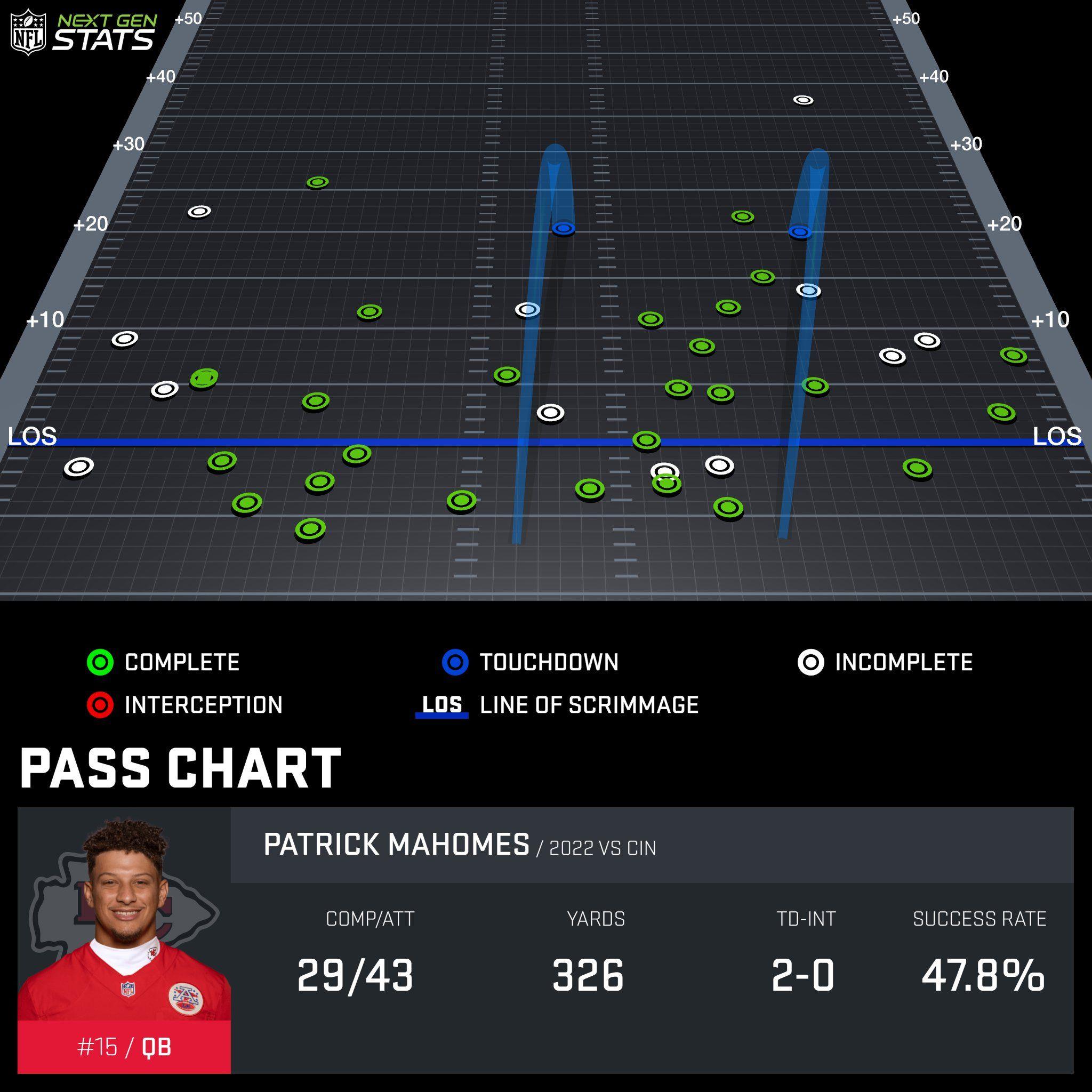The biggest winner of Sunday’s conference championship games wasn’t the Eagles or Chiefs. It was the NFL on Fox marketing team, whose job it will be to sell the Super Bowl matchup to a worldwide audience over the next two weeks. That task is a lot easier with the top two MVP candidates squaring off: Jalen Hurts, a third-year pro who has broken out as a key cog in Philadelphia’s stacked offense, versus Patrick Mahomes, who’s coming off the best season of his career.
The game will be billed as a battle of this season’s two best quarterbacks, but let’s be honest: That’s not a fair fight. Mahomes isn’t just the league’s best quarterback. He might be the best we’ve ever seen, and Hurts just isn’t in that realm at this point in his development. That’s not a dig at the Eagles star. Mahomes should be the better player. He’s been doing it longer, he has a generational-level skillset, and he gets paid a lot more money. Plus the reason the Eagles are in the Super Bowl isn’t just Hurts: it’s also the talent around him.
Simply put, Hurts has a lot more help than Mahomes. He throws to DeVonta Smith and A.J. Brown; he stands behind the best offensive line in football. His job is objectively easier, and that context can’t be ignored when comparing the two quarterbacks—nor can the fact that Hurts’s salary, which takes up a much smaller chunk of the cap than Mahomes, has given the Philly front office the ability to acquire that kind of top talent at other positions.
Every NFL team wants a Mahomes at quarterback, but there are only so many of those to go around. The next best thing, as we’ve found out from a few franchises this season, is finding a passer who can produce on a rookie contract and let his team spend big money elsewhere. And that’s what makes this matchup so compelling: Mahomes is everything NFL teams want their quarterback to be. The Eagles are everything an NFL quarterback wants their team to be. Kansas City has found the ultimate franchise quarterback—the kind who will keep his team in title contention as long as he’s healthy. And Philadelphia has built a roster that’s too good to fail. Super Bowl LVII will be a testing ground pitting these two roster builds against one another—and the winner could influence how teams on the brink of contention go about constructing their rosters in the near future.
Sunday’s games offered up convincing endorsements of both set ups. The Eagles took advantage of a 49ers team that was dealing with a quarterback crisis in a 31-7 win. San Francisco started the game with Brock Purdy under center, the last pick of April’s draft who’d guided the Niners on a 8-0 stretch to end the season. But Purdy suffered an elbow injury on the first drive of the game, and coach Kyle Shanahan had to bring in Josh Johnson, the team’s fourth-string QB. Then, early in the third quarter, Johnson went down with a concussion and a limited Purdy was forced back into the game. The Niners’ other option was to use Christian McCaffrey as an emergency QB.
Because of his injury, Purdy could only really hand the ball off. And while that fact certainly made things easier for the Philadelphia defense, I’m not sure the end result would have changed much even if Purdy was healthy. The Eagles dominated the trenches on both sides of the ball. They had a clear matchup advantage at receiver, and they could have exploited it further if the game hadn’t been put away so early.
It was harder for Kansas City, which had to overcome a strong defensive effort from Cincinnati to pull out a last-second victory over a talented Bengals team. Mahomes didn’t get much support from Kansas City’s run game—which managed just five attempts that produced a positive EPA, tying Miami and Tampa Bay for the lowest in a game this postseason, per TruMedia—and he was down to one starting receiver after Kadarius Toney, Mecole Hardman, and JuJu Smith-Schuster all left the game with injuries. But even with everything going wrong, and despite still dealing with the effects of a high-ankle sprain, Mahomes was enough to pull out the win.
Based on Sunday’s results, and really what we’ve been seeing all season, Philadelphia’s situation seems to be the better of the two. The Eagles don’t ask their quarterback to be perfect, and the team has proven it can dominate good competition even when Hurts isn’t playing his A game. Take Sunday’s contest, where I’m not even sure we saw his B game. Hurts missed throws, he never looked over-comfortable in the pocket despite the Eagles dominance in the trenches, and even some of his big completions required impressive adjustments by the receivers—or missed calls by the refs.
Hurts averaged 4.7 yards per dropback with a 37-percent success rate against the Niners, both near season lows, per TruMedia. He was inaccurate on 16.0 percent of his throws, his third-worst mark of the season. And this happened while playing behind an offensive line that allowed pressure on only 25.9 percent of his dropbacks. None of that mattered in the end. The Eagles put up 31 points without breaking a sweat thanks to a defense that overwhelmed a hamstrung Niners offense, and a historically dominant run game that shows up every week.
That last part cannot be ignored when discussing Hurts’s contribution to Sunday’s win. While Hurts didn’t throw the ball well, his presence in the run game was a significant factor in Philadelphia’s success. The Eagles averaged 0.15 EPA per designed run attempt with a 45 percent success rate in the game. A third of Philly’s runs went for first downs, and Hurts was the centerpiece of the run plan. Almost every call asked him to read an unblocked defender and decide whether to hand the ball off to the back or keep it for himself based on the movement of that player. His gravity created some of those wide open rush lanes for the Eagles ball carriers.
And when the ball stayed in Hurts’s hands, he created those rush lanes for himself.
Hurts didn’t just slap his name on the group project and get an A. He did his part and earned his trip to the Super Bowl. And it’s not like Hurts is the first quarterback to be surrounded by talent. The Eagles weren’t the outliers this past weekend. The Bengals have provided Joe Burrow with a deep group of playmakers and a formidable defense that has kept him in every playoff game he’s ever been part of. The 49ers were deep enough to turn Mr. Irrelevant into a Rookie of the Year candidate in only half a season. This NFL season has been defined by strong supporting casts, as we’ve seen superstar quarterbacks around the league buckle under the weight of poorly constructed rosters: Josh Allen’s hero routine wasn’t nearly enough for Buffalo; Justin Herbert and Lamar Jackson rarely got to play with their full complement of weapons; even Aaron Rodgers and Tom Brady couldn’t elevate their teams to a winning record.
And that’s what makes Mahomes’s return to the Super Bowl so damn impressive. This is the highest degree of difficulty he’s had to deal with since becoming a full-time starter in 2018. He still has Travis Kelce, who will be headed to Canton on the first ballot, and Andy Reid calling his plays. But that’s about it. His receiving corps is made up of players who were cast aside by their former teams. The offensive line is good but not great. The defense has been opportunistic and very good in the playoffs, but it produced mediocre results throughout the regular season. No Super Bowl team is truly a one-man show, but Mahomes has elevated a good roster into one that’s capable of winning it all. There isn’t another quarterback who could extract the same results out of his group.
I’m not even sure last year’s version of Mahomes would have been capable of winning Sunday’s game against the Bengals. That version is certainly capable of making all the impressive downfield throws we saw, but the updated Mahomes has unlocked the power of the expertly timed checkdown, which has added another layer to the passing attack. That wasn’t the case when Cincinnati frustrated the superstar quarterback in last year’s AFC title game by using a conservative gameplan that took away the deep parts of the field. But this time, Mahomes was more than willing to play that game, which we have seen throughout his MVP campaign this season.
This is me shamelessly doing the If Mahomes did this, people wouldn’t shut up about it for a week trope. I’m giving him credit for throws that Kirk Cousins makes routinely. But there seems to be more substance when Mahomes makes those plays, which are really only used as last resort options in this offense. When the Chiefs throw a checkdown, it’s usually because the defense has left that as the most efficient option, and not because Mahomes panicked and couldn’t find a better outlet. No quarterback racked up more EPA on throws to running backs flaring out of the backfield than Mahomes did in 2022, according to TruMedia. The NFL’s undisputed king of checkdowns, Brady, was second on the list. Mahomes is even doing the boring things better than his older peers at this point.
Mahomes is no longer playing the same reckless brand of football that he has gotten away with in the past, and he’s been a more consistent quarterback as a result. His degree of difficulty is as high as ever, though. While he’s lowered his average depth of target, the range of passes he’s being asked to hit is still large. It’s just more spread out horizontally. Some of the deep targets that used to go to Tyreek Hill have been replaced by midrange throws to newcomers Smith-Schuster and Marquez Valdes-Scantling. If over his first four years as a starter Mahomes was the NFL’s Steph Curry, in Year 5, he’s transformed into its Michael Jordan. Even on a bad ankle and without three of his top four receivers, Mahomes sprayed the ball over the field and forced the Bengals to defend every blade of grass.

This Chiefs team wouldn’t be in this Super Bowl if not for this more mature iteration of Mahomes—one whose play is able to rise above whoever he has around him or whatever the defense throws at him. Philadelphia, on the other hand, wouldn’t still be playing if not for Hurts producing at a high level while also making only a fraction of what he’s worth. We’ll spend the next two weeks hopelessly debating which setup is best, and that discussion will resume immediately following the game’s conclusion with the result being held up as a referendum on the proper way to build a roster. But whether any of this is repeatable is its own question.
The Chiefs could win it all with a star-centric offense that asks its quarterback to do everything, but the AFC playoffs proved there’s only one of those quarterbacks walking this planet at the moment. The Eagles could win it all with a Day 2 quarterback making less than the team’s kicker, but good luck assembling the kind of talent that floods the rest of the roster. That’s not going to stop this copycat league from living up to its reputation and attempting to replicate the success of whichever team ends up winning this matchup. But really what this Super Bowl will determine more than anything is which of these strategies was best for this season—and the way this philosophical debate might sway next.
